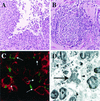Immunopathogenesis of Haemophilus ducreyi infection (chancroid)
- PMID: 11895928
- PMCID: PMC127820
- DOI: 10.1128/IAI.70.4.1667-1676.2002
Immunopathogenesis of Haemophilus ducreyi infection (chancroid)
Figures


References
-
- Abeck, D., A. L. Freinkel, H. C. Korting, R. M. Szeimis, and R. C. Ballard. 1997. Immunohistochemical investigations of genital ulcers caused by Haemophilus ducreyi. Int. J. STD AIDS 8:585-588. - PubMed
-
- Abu Kwaik, Y., R. E. McLaughlin, M. A. Apicella, and S. M. Spinola. 1991. Analysis of Haemophilus influenzae type b lipooligosaccharide-synthesis genes that assemble or expose a 2-keto-3-deoxyoctulosonic acid epitope. Mol. Microbiol. 5:2475-2480. - PubMed
-
- Al-Tawfiq, J. A., M. E. Bauer, K. R. Fortney, B. P. Katz, A. F. Hood, M. Ketterer, M. A. Apicella, and S. M. Spinola. 2000. A pilus-deficient mutant of Haemophilus ducreyi is virulent in the human model of experimental infection. J. Infect. Dis. 181:1176-1179. - PubMed
-
- Al-Tawfiq, J. A., K. R. Fortney, B. P. Katz, C. Elkins, and S. M. Spinola. 2000. An isogenic hemoglobin receptor-deficient mutant of Haemophilus ducreyi is attenuated in the human model of experimental infection. J. Infect. Dis. 181:1049-1054. - PubMed
Publication types
MeSH terms
Substances
Grants and funding
LinkOut - more resources
Full Text Sources
Research Materials

